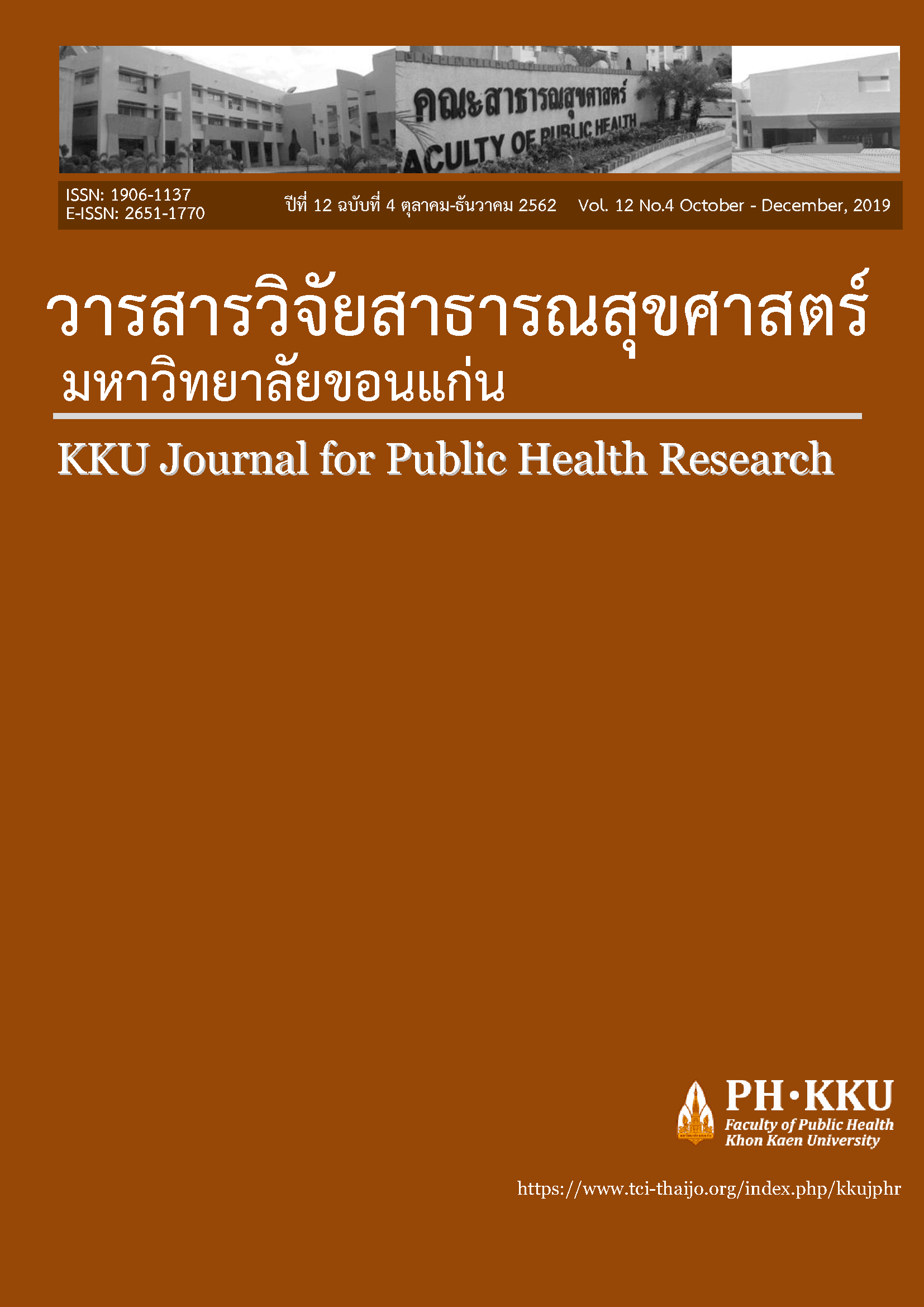Anemia in Female Students of Ethnic Minorities in Northern Vietnam
คำสำคัญ:
ภาวะเลือดจาง, ภาวะขาดธาตุเหล็ก, ธาลัสซีเมีย, ชนกลุ่มน้อยชาติพันธุ์บทคัดย่อ
ภาวะเลือดจางเป็นหนึ่งในปัญหาสุขภาพที่พบในชนกลุ่มน้อย โดยมีสมมติฐานว่าเกิดจากการขาดธาตุเหล็กเป็นหลัก การศึกษานี้มีวัตถุประสงค์เพื่อหาค่าความชุกภาวะเลือดจาง และภาวะเลือดจางจากการขาดธาตุเหล็กในผู้หญิงวัยเจริญพันธุ์ที่เป็นชนกลุ่มน้อยในเขตภาคเหนือของประเทศเวียดนาม อาสาสมัครเป็นนักศึกษาแพทย์กลุ่มชาติพันธุ์ที่กำลังศึกษา ณ มหาวิทยาลัยไทเหงียน เก็บรวบรวมข้อมูลด้านประชากรและสังคม และสถานะสุขภาพโดยการสัมภาษณ์ เก็บตัวอย่างเลือดและนำไปตรวจความสมบูรณ์ของเม็ดเลือด (Complete blood count: CBC) วินิจฉัยภาวะเลือดจางโดยอาศัยเกณฑ์ระดับฮีโมโกลบินน้อยกว่า 12 กรัม/เดซิลิตร นำตัวอย่างเลือดที่พบภาวะเลือดจางมาตรวจวัดระดับเฟอร์ไรตินในซีรั่ม วินิจฉัยภาวะเลือดจางจากการขาดธาตุเหล็กในผู้ที่มีภาวะเลือดจางและมีระดับเฟอร์ไรตินในซีรั่มน้อยกว่า 15 นาโนกรัมต่อมิลลิลิตร ส่วนการบ่งชี้พาหะธาลัสซีเมียใช้ค่าปริมาตรเม็ดเลือดแดงเฉลี่ย (Mean corpuscular volume: MCV) และการทดสอบ Dichlorophenol-indophenol precipitation (DCIP) จากผู้หญิงจำนวน 275 คน พบความชุกภาวะเลือดจาง และภาวะเลือดจางจากการขาดธาตุเหล็ก ร้อยละ 31.6 (ช่วงเชื่อมั่น ร้อยละ 95 =26.2-37.5) และ ร้อยละ 7.6 (ช่วงเชื่อมั่นร้อยละ 95 =4.8-11.4) ตามลำดับ จากการคัดกรองด้วย MCV/DCIP พบพาหะธาลัสซีเมียในผู้หญิง 95 คน (ร้อยละ 34.5, ช่วงเชื่อมั่นร้อยละ 95 = 28.9-40.5) ในกลุ่มผู้หญิงที่มีภาวะเลือดจาง พบว่า ร้อยละ 75.9 มีสถานภาพเหล็กปกติ มีภาวะขาดธาตุเหล็ก ร้อยละ 24 และเป็นพาหะธาลัสซีเมีย ประมาณร้อยละ 68 ปัจจัยที่สัมพันธ์กับภาวะเลือดจางอย่างมีนัยสำคัญทางสถิติ คือ ผลการตรวจคัดกรองบวก (Odds Ratio=8.9; ช่วงเชื่อมั่นร้อยละ 95 =5.9-15.9) ข้อค้นพบนี้ นอกจากจะเป็นประโยชน์สำหรับการกำหนดมาตรการป้องกันภาวะเลือดจางแล้ว ยังเป็นประโยชน์ต่อการกำหนดมาตรการป้องกันโรคธาลัสซีเมียในชนกลุ่มน้อยอีกด้วย
เอกสารอ้างอิง
Aikawa, R., Ngyen, C. K., Sasaki, S., & Binns, C. W. (2006). Risk factors for iron-deficiency anaemia among pregnant women living in rural Vietnam. Public Health Nutrition, 9(4), 443–448.
Fucharoen, G., Sanchaisuriya, K., Sae-ung, N., Dangwibul, S., & Fucharoen, S. (2004). A simplified screening strategy for thalassaemia and haemoglobin E in rural communities in south-east Asia. Bulletin of the World Health Organization, 82(5), 364–372.
General Statistical Office. (2009). The 2009 Vietnam population and housing census: Completed results. Hanoi, Vietnam: Statistical Publishing House, General Statistical Office.
Glader, B. (2009). Anemia: General consideration. In J. P. Greer, J. Foerster, G. M. Rodgers, F. Paraskevas, B. Glader, D. A. Arber, et al., (Eds.). Wintrobe’s clinical hematology (12th ed., p. 779-809). Philadelphia: Lippincott Williams & Wilkins.
Karakochuk, C. D., Whitfield, K. C., Barr, S. I., Lamers, Y., Devlin, A. M., Vercauteren, S. M., et al. (2015). Genetic hemoglobin disorders rather than iron deficiency are a major predictor of hemoglobin concentration in women of reproductive age in rural prey Veng, Cambodia. The Journal of Nutrition, 145(1), 134–142.
Nguyen, H. V., Sanchaisuriya, K., Nguyen, D., Phan, H. T. T., Siridamrongvattana, S., Sanchaisuriya, P., et al. (2013). Thalassemia and hemoglobinopathies in Thua Thien Hue Province, Central Vietnam. Hemoglobin, 37(4), 333–342.
Nguyen, N. T., Sanchaisuriya, K., Sanchaisuriya, P., Van Nguyen, H., Phan, H. T. T., Fucharoen, G., et al. (2017). Thalassemia and hemoglobinopathies in an ethnic minority group in Central Vietnam: implications to health burden and relationship between two ethnic minority groups. Journal of Community Genetics, 8(3), 221–228.
Nguyen, P. H., Nguyen, K. C., Le Mai, B., Nguyen, T. V., Ha, K. H., Bern, C., et al. (2006). Risk factors for anemia in Vietnam. The Southeast Asian Journal of Tropical Medicine and Public Health, 37(6), 1213–1223.
Nguyen, V. H., Sanchaisuriya, K., Wongprachum, K., Nguyen, M. D., Phan, T. T. H., Vo, V. T., et al. (2014). Hemoglobin Constant Spring is markedly high in women of an ethnic minority group in Vietnam: A community-based survey and hematologic features. Blood Cells, Molecules & Diseases, 52(4), 161–165.
Nhien, N. V., Khan, N. C., Ninh, N. X., Van Huan, P., Hop, L. T., Lam, N. T., et al. (2008). Micronutrient deficiencies and anemia among preschool children in rural Vietnam. Asia Pacific Journal of Clinical Nutrition, 17(1), 48–55.
Nhien, N. V., Khan, N. C., Yabutani, T., Ninh, N. X., Chung, L. T. K., Motonaka, J., et al. (2008). Relationship of low serum selenium to anemia among primary school children living in rural Vietnam. Journal of Nutritional Science and Vitaminology, 54(6), 454–459.
O’Riordan, S., Hien, T. T., Miles, K., Allen, A., Quyen, N. N., Hung, N. Q., et al. (2010). Large scale screening for haemoglobin disorders in southern Vietnam: implications for avoidance and management. British Journal of Haematology, 150(3), 359–364.
Panomai, N., Sanchaisuriya, K., Yamsri, S., Sanchaisuriya, P., Fucharoen, G., Fucharoen, S., et al. (2010). Thalassemia and iron deficiency in a group of northeast Thai school children: relationship to the occurrence of anemia. European Journal of Pediatrics, 169(11), 1317–1322.
Sanchaisuriya, K., Fucharoen, S., Fucharoen, G., Ratanasiri, T., Sanchaisuriya, P., Changtrakul, Y., et al. (2005). A reliable screening protocol for thalassemia and hemoglobinopathies in pregnancy: an alternative approach to electronic blood cell counting. American Journal of Clinical Pathology, 123(1), 113–118.
Sanchaisuriya, K., Fucharoen, S., Ratanasiri, T., Sanchaisuriya, P., Fucharoen, G., Dietz, E., et al. (2006). Thalassemia and hemoglobinopathies rather than iron deficiency are major causes of pregnancy-related anemia in northeast Thailand. Blood Cells, Molecules & Diseases, 37(1), 8–11.
Savongsy, O., Fucharoen, S., Fucharoen, G., Sanchaisuriya, K., & Sae-Ung, N. (2008). Thalassemia and hemoglobinopathies in pregnant Lao women: carrier screening, prevalence and molecular basis. Annals of Hematology, 87(8), 647–654.
Thurlow, R. A., Winichagoon, P., Green, T., Wasantwisut, E., Pongcharoen, T., Bailey, K. B., et al. (2005). Only a small proportion of anemia in northeast Thai schoolchildren is associated with iron deficiency. The American Journal of Clinical Nutrition, 82(2), 380–387.
Van Nhien, N., Yabutani, T., Khan, N. C., Khanh, L. N. B., Ninh, N. X., Chung, L. T. K., et al. (2009). Association of low serum selenium with anemia among adolescent girls living in rural Vietnam. Nutrition, 25(1), 6–10.
Weatherall, D. J., & Clegg, J. B. (2001). The thalassemia syndromes (4th ed.). Oxford: Blackwell Science.
WHO. (2001). Iron deficiency anaemia: Assessment, prevention, and control, a guide for programme managers. Geneva: WHO.
Wongprachum, K., Sanchaisuriya, K., Dethvongphanh, M., Norcharoen, B., Htalongsengchan, B., Vidamaly, V., et al. (2016). Molecular Heterogeneity of Thalassemia among Pregnant Laotian Women. Acta Haematologica, 135(2), 65–69.
World Health Organization [WHO]. (2008). Worldwide prevalence of anaemia 1993–2005. Geneva: WHO.
World Health Organization [WHO]. (2015). The global prevalence of anemia in 2011. Geneva: World Health Organization.



